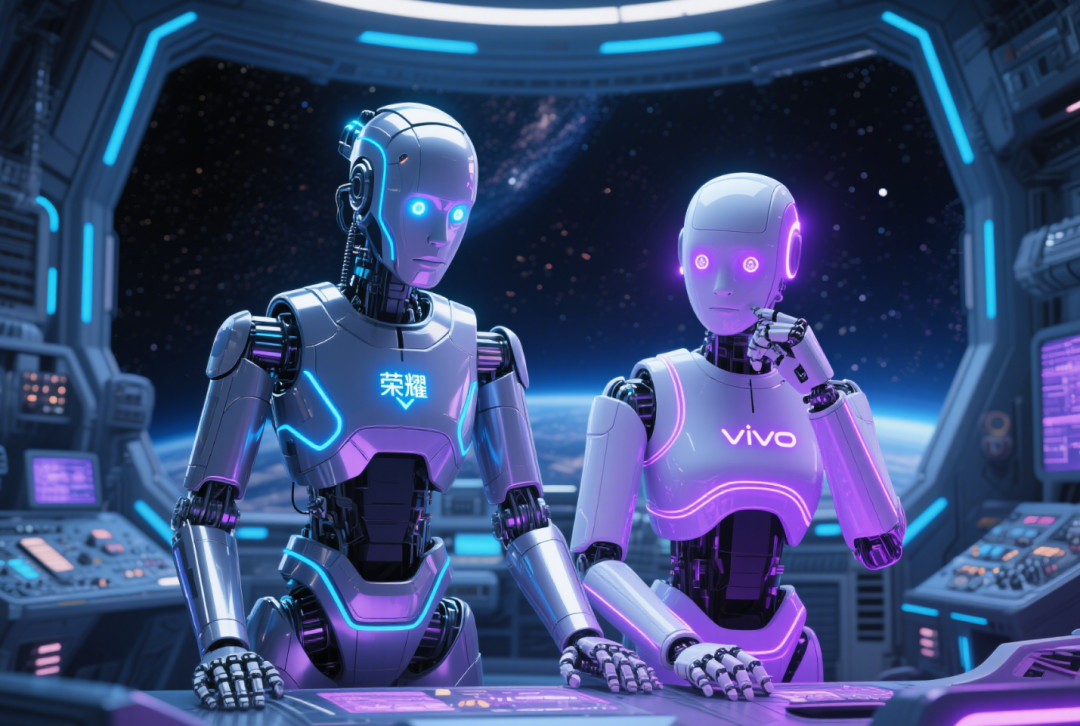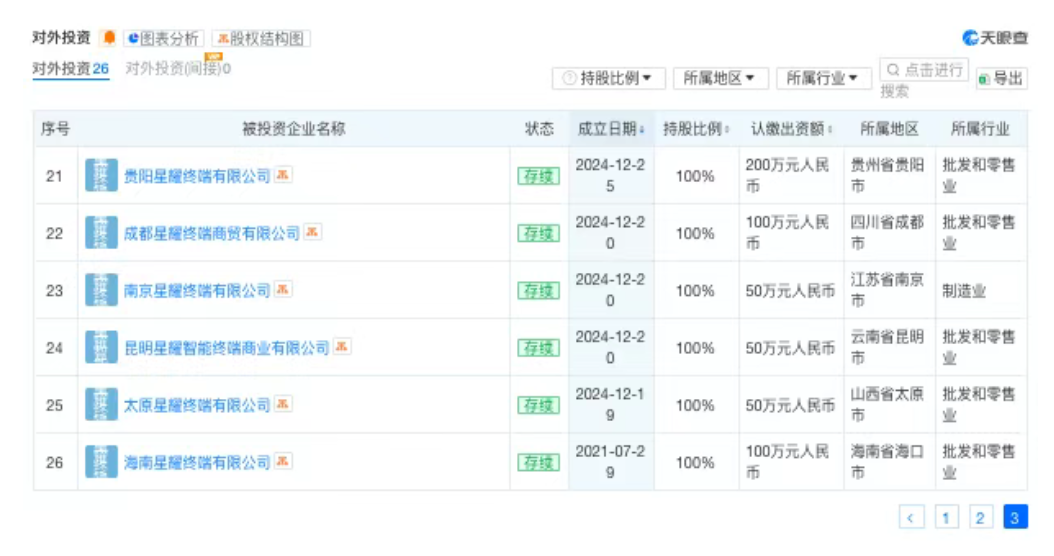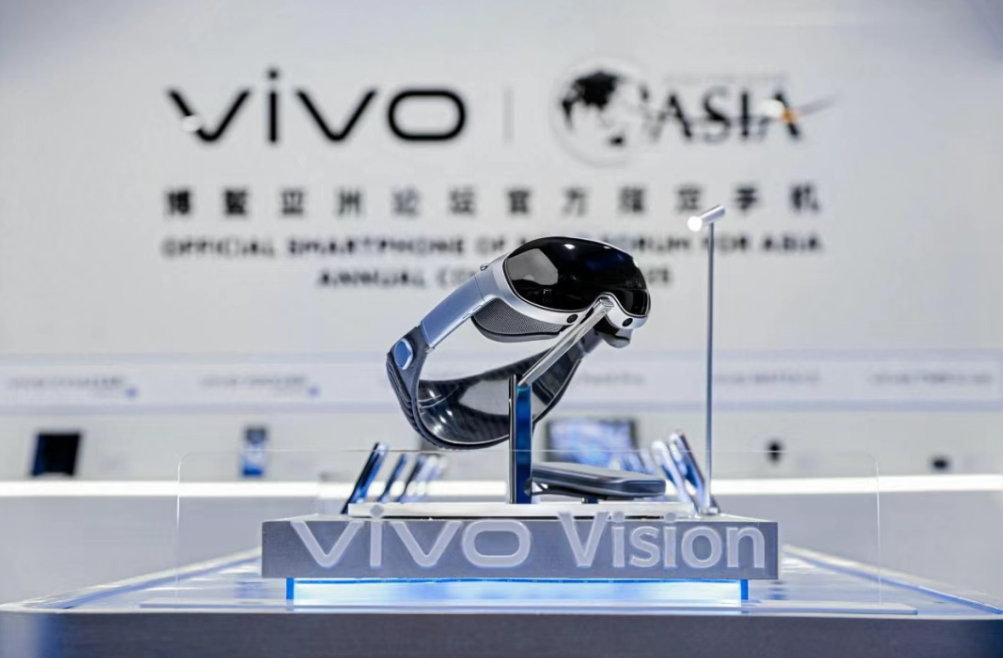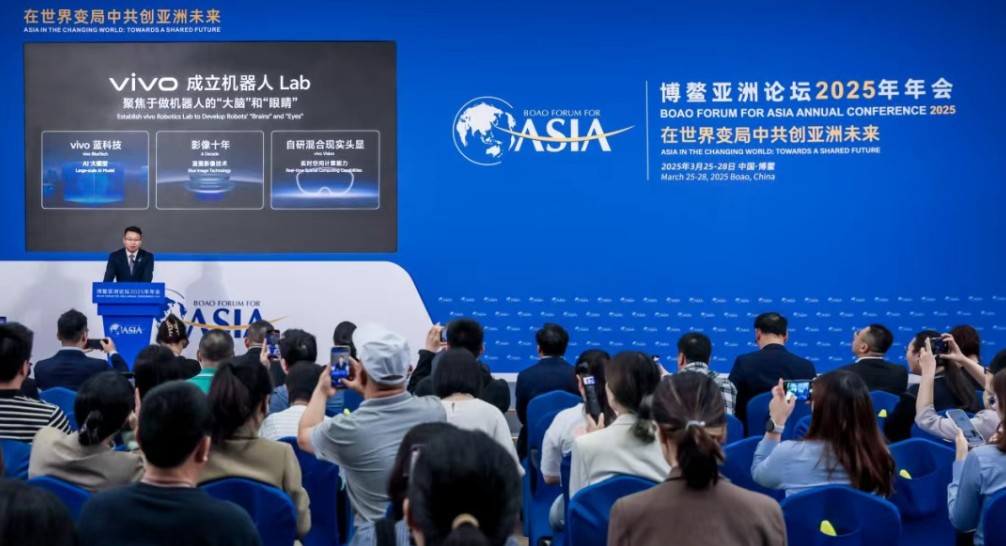On May 28, Honor announced at the Mobile World Congress in Barcelona that it will invest $10 billion to promote its artificial intelligence strategy, focusing on the development of humanoid robots and entering the fiercely competitive AI field in China.
Recently, at the Boao Forum for Asia Annual Conference 2025, vivo also announced the establishment of the vivo Robotics Laboratory, officially entering the robotics industry.
The humanoid robot battle among mobile manufacturers has officially begun in 2025.

▍What Drives the Humanoid Plan?
The entry of mobile manufacturers into the humanoid robot industry is not a coincidence, but a necessary extension of their smart hardware ecosystem development.
Smartphones, as important carriers of human digitalization, deeply record massive physical behavior data such as users’ movement trajectories, home usage habits, and imaging preferences. These data resources are like digital treasures, providing a solid foundation for the subsequent technological expansion of humanoid robots.
Meanwhile, mobile manufacturers have over 1 billion smart device users globally. This vast user base is not only consumers of products but also a natural testing ground for new features and applications. The rich experience accumulated by manufacturers in ecological construction over the years can quickly adapt to the needs of robots.
From the perspective of hardware capabilities, mobile manufacturers have been committed to connecting the physical world with the digital world. However, due to limitations in chip processes and device sizes, mobile devices struggle to handle complex computational tasks.
Humanoid robots, as mobile computing terminals, are not constrained by portability and can carry high-performance chips and distributed computing architectures to support the operation of multimodal AI models, expanding the technical advantages of mobile manufacturers from mere information processing to direct intervention in the physical world.
It can be said that robots have achieved a leap from two-dimensional interactive terminals to three-dimensional intelligent entities. Furthermore, if robots succeed in AI Agent scenarios in the future, their capabilities can also be adapted back to smartphones and MR devices, forming a closed-loop ecosystem of technological feedback.

In terms of industrial development, the mass production of humanoid robots has always faced significant challenges, including low localization rates of key components, high hardware costs, and immature supply chains, which restrict the industry’s growth.
In contrast, the smartphone industry has a supply chain overlap of over 60% with robotics, having formed a mature specialized division of labor system.
Mobile manufacturers can leverage this advantage to introduce the mass production and rapid iteration model of the 3C industry into robot manufacturing, significantly reducing hardware costs.
At the same time, leading mobile manufacturers can also promote the standardization process of the robotics industry by establishing technical standards for the supply chain, just as vivo has integrated imaging calibration standards into the supply chain inspection process.
For mobile manufacturers, the layout of humanoid robots is not only an expansion of the ecological map but also a redefinition of the next generation of “physical world operating systems.”
With the vast global consumer base, cutting-edge technological ecosystem, and diverse application scenarios, humanoid robots are expected to break through the limitations of laboratories and become a true bridge connecting the physical and digital worlds.
Therefore, this cross-industry integration by mobile manufacturers is not only related to the development of enterprises but also represents another transformation of human tools, marking an important step towards “digital physical existence” and is expected to open a new chapter in the development of intelligent devices.
However, the robot strategies of the two mobile giants are diverging fundamentally from a technical standpoint.
From the press conference, one side showcases a running steel body, while the other presents a thinking digital brain, which essentially means that Honor is attempting to focus on hardware, while vivo is betting more on AI.
Honor’s manufacturing ambition is to replicate the myth of the smartphone supply chain. To this end, Honor is transferring its smartphone supply chain advantages to the robotics field.
In contrast, vivo’s ecological ambition is to not build robots but to create the “iOS” for robots.
The two companies have already shown signs of a split in their technical routes.
▍Honor’s Humanoid Robot
Honor’s entry into the humanoid robot field is mainly due to the increasingly fierce competition in the smartphone market, as it needs to create a new growth curve as an AI terminal ecosystem company, making robots an important attempt.
Thus, humanoid robots are just part of its $10 billion new industry expansion strategy, aimed at helping Honor transform from a traditional consumer electronics company to an AI-driven ecosystem enterprise.
In terms of business layout, Honor adopts a full-chain expansion strategy in the humanoid robot field. Through the establishment of Guiyang Xingyao Terminal Co., Ltd. in 2021 and the newly established Harbin Xingyao Terminal Co., Ltd. in April 2025, it has included intelligent robot sales in its business scope, forming a complete business closed loop from R&D, production to market promotion, with the possibility of separate financing in the future.

At the same time, Honor has also initiated organizational structure optimization, with a newly established new industry incubation department specifically responsible for breakthroughs in core robot technologies. The global brand department focuses on market demand research and user scenario exploration, and through the “Eagle Plan,” it aims to attract top talents in fields such as motion control and embodied intelligence to provide human resources support for technological R&D.
In terms of technological R&D, Honor has shown multidimensional breakthroughs, but the core focus is on hardware. Their approach has been described by investors as: “Investing in the body now is like betting on horses; it’s better to invest in core modules. No matter who comes out on top, these types of companies can win.”
At a previous press conference, Honor showcased a robot prototype equipped with its self-developed motion control system, utilizing high-precision servo motors and proprietary dynamic balance algorithms, achieving a stable running speed of 4 meters per second. It also demonstrated excellent anti-bump capabilities and terrain adaptability through real-time environmental perception data to adjust joint torque during tests on complex terrains such as mountain roads and parks.
Reports indicate that this multimodal perception system integrates visual, auditory, and tactile sensors, capable of synchronously collecting data on environmental light intensity, sound frequency, and object texture, and constructing environmental semantic maps using deep learning algorithms to achieve millisecond-level responses for dynamic obstacle avoidance and path planning.
In terms of communication and computational support, Honor is attempting to combine the low-latency characteristics of 5G networks with the edge computing capabilities of its self-developed chips to build an “end-cloud collaboration” architecture—local chips process real-time perception data while cloud-based large models complete complex decisions, ensuring data transmission stability while reducing reliance on a single hardware computing power.

In terms of ecosystem construction, Honor continues the open strategy from the smartphone field, planning to open the HONOR AI Connect platform, collaborating with the education sector to develop intelligent teaching assistants, customizing environmental monitoring robots for home scenarios, and co-creating inspection solutions with the industrial sector. By sharing technical capabilities through API interfaces, it aims to attract more developers to create vertical scene applications based on robot hardware, attempting to replicate its collaborative model in the smartphone ecosystem.
Honor stated that its current robot business is in the “incubation stage,” focusing on core technology R&D and scenario research, striving for commercial landing that precisely matches market pain points. In the future, based on a technology route evolved from hardware, its breakthroughs may accelerate the iteration of the industry supply chain, promoting progress in key indicators of humanoid robots and helping China demonstrate its leading ambitions in this field globally.
▍vivo’s Humanoid Robot Plan
vivo’s entry into humanoid robotics is also driven by the saturation of the smartphone market, as the company needs to find new growth curves. However, it believes that robotics aligns better with its core capabilities in AI large models, imaging, and real-time spatial computing, offering more long-term potential compared to automotive manufacturing.
In terms of specific direction, vivo has clearly defined its boundaries: it will not build limbs but will provide “brain and eye kits.” vivo hopes to focus on differentiation by centering on the “brain” and “eyes.”
In developing the “eyes” (environmental perception), vivo aims to leverage its imaging technology advantages accumulated during the smartphone era.
vivo’s self-developed imaging chip V3 achieves hardware-level acceleration for 4K cinematic portrait blurring, and the blueprint imaging algorithm can perform real-time semantic segmentation in complex lighting environments. These technologies are directly transferred to the robot’s visual system, enabling it to accurately identify object materials, assess spatial distances, and restore true environmental colors.
At the same time, vivo’s first MR mixed reality headset, vivo Vision, becomes an important supplement for spatial perception. Its front panel integrates multiple ToF cameras and IMU sensors, which can quickly construct three-dimensional spatial maps, identifying environmental features such as furniture layout and door/window positions, providing foundational data for the robot’s autonomous navigation in home scenarios.

The development of the “brain” (intelligent decision-making) also relies on vivo’s deep AI technology reserves, focusing more on horizontal extension of technology.
Since the establishment of the AI Global Research Institute in 2018, vivo has accumulated a research and development team of over 1,000 people in the fields of knowledge graphs and natural language processing, and has released the Blue Heart large model matrix. Among them, the cloud-based trillion-level model ranks in the top tier in Chinese rankings such as C-Eval and CMMLU, providing strong computational support for the robot’s autonomous decision-making.
The AI Agent training framework developed based on this can simulate human behavioral logic in home scenarios—for example, learning user routines through historical data to automatically adjust indoor lighting brightness or recommending recipes based on available ingredients.
The PhoneGPT intelligent agent, which has already been implemented on mobile devices, demonstrates cross-App operational capabilities (such as completing restaurant reservations via voice commands). vivo hopes that this capability will be transferred to robots in the future, achieving full-process automation from “perceiving needs” to “executing tasks.”
In terms of business model, vivo has clearly defined its boundaries: it will not enter the industrial robot field, focusing on personal and family consumer scenarios; it will not self-develop mechanical arms or dexterous hands but will engage in customized development through partnerships with industry chain partners (such as servo motor manufacturers and sensor suppliers).
This “light asset” strategy allows it to focus on core technologies—such as collaborating with certain university laboratories to develop tactile feedback algorithms and co-creating intelligent linkage protocols with home brands, accelerating the landing of technology through division of labor and cooperation.
“In the future, buying a robot will be like configuring a computer—choosing vivo chips + large models, and then pairing them with a preferred body,” an investor metaphorically stated.
In attracting talent, vivo has also posted multiple robot positions with annual salaries exceeding one million on third-party recruitment platforms, focusing on recruiting high-end talents with experience in embodied intelligence and multimodal large model training. Currently, the MR-related personnel count has reached 500, with plans to launch a high-fidelity MR prototype in the fall of 2025, providing a testing platform for the robot’s environmental perception capabilities.
In the future, vivo expects to achieve a closed-loop experience with robot prototypes in 3-5 years, while commercializing for consumers will take longer. It will introduce targeted products in specific scenarios through a path of “progressive breakthroughs and laying eggs along the way,” allowing technology to enter users’ lives. Its MR headset and other achievements will pave the way for robot commercialization, striving for a technological feedback loop between “robots, smartphones, and MR.”

▍Conclusion: The Next-Generation War of Mobile Manufacturers
Most in the industry hold an optimistic view regarding mobile manufacturers entering the field.
“Just like when Apple forced Foxconn to improve yield rates,” pointed out an analyst from Guotai Junan, “the entire 3C supply chain is expected to become roboticized.”
Some analysts even boldly claim that if Honor can reduce the overall machine cost from 500,000 to 80,000 within three years, they could become the “Xiaomi” of humanoid robots.
“After all, they are major clients,” industry insiders explained to us. “Because if the imaging CMOS sensors can be reused in the robot’s eye array, costs could be reduced by 40%. This is a dimensionality reduction strike.”
As Honor’s humanoid robots attempt to run in factories, and vivo’s AI constructs a digital twin world in the minds of humanoid robots, this competition has already transcended hardware itself—this is a battle over “who controls the next generation of human-machine interaction interfaces.”
As an expert stated in an interview: “Mobile is not just a phone, but the bridge to the future.”(Mobile is not just a phone, but the bridge to the future)
—————-END——————-

Recommended Reading
*Surprising! The humanoid companion robot track is completely boiling
*China occupies 63% of the humanoid supply chain? Morgan Stanley releases the humanoid robot ecological value chain map, categorizing and interpreting 100 companies
*From 1 hour to 8 hours: The evolution of humanoid robot batteries
*How far are we from mass production of humanoid robots in 2025? An overview of the progress of various companies (Part II)
*Yushu humanoid robot concept stocks
*Effort plans to cooperate with Seres, Chery, and Zhongding Co., Ltd. to accelerate the application of general bases, showcasing humanoid robots on-site
*21 kilometers half marathon, which humanoid robot can finish?
*Humanoid robots’ nine major development trend predictions
Submissions and Inquiries
We are collecting articles related to humanoid robots research and industrialization. You can contact editor WeChat: Jack (16602151154, same number for mobile and WeChat) for submissions and exchanges! For inquiries regarding corporate cooperation, please contact Dr. Tang (13810423387, same number for mobile and WeChat) for coordination.
Feeling tired? Click “View” to support us!